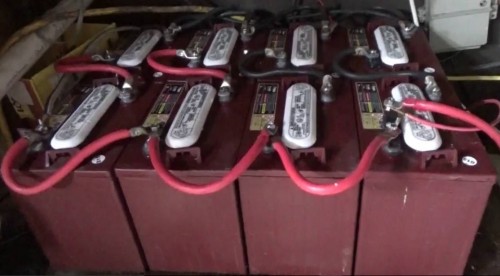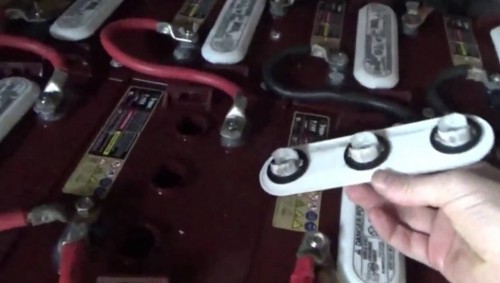All About Batteries - Charging - Maintenance - Voltages
I get asked quite often about batteries. There are many questions but most of them are about solar power and off grid environments. Today I talk about batteries, battery maintenance, voltages and how to check the water levels.
The information in this article fits both solar power batteries and automotive batteries. Basically any lead acid battery needs the same type of care and maintenance in order to extend their serviceable life.
 All about batteries and battery maintenance
All about batteries and battery maintenance
Battery Basics
When you live off the grid your batteries store all the energy you need to power your home each day. It is very important to learn how to take care of your off grid battery bank in order to prolong their service life. With the proper care and maintenance you can extend the usable life of your battery bank.
First of all keep your batteries clean. I wash my batteries with a coarse plastic bristle brush and a baking soda and water mix. I dip the brush into the water and baking soda and then brush off any debris or acid residue on top of the batteries. I also scrub any of the battery terminals if needed. The battery terminals will corrode with time and need to be kept clean. Baking soda neutralizes the battery acid when you wash the batteries rendering it harmless.
Then I rinse the batteries off well with fresh water and let them dry.
Keep your batteries out of direct sunlight. Sun light will degrade the plastic case of the battery and eat it away with time. Also keep your batteries in a cool dry place. Any extremes of heat or cold will lower the usable energy that a battery has. Most normal summer and winter temperatures will not harm a normal, fully charged battery but it will reduce the amount of usable energy in the battery.
I keep our off grid battery bank inside a shed that I built just for this purpose. It keeps the batteries out of the elements and out of the sunlight. It also keeps the battery temperature a bit more stable all year. In summer the shed will be cooler than the outside air. In winter I can heat the shed to keep a stable and cozy battery temperature.
That is why most car batteries fail in the winter months. Winter is harsh on a battery and there is less energy to give up for starting the vehicle. So eventually the battery fails.
Excess heat and vibration are also bad for batteries. This is another reason that a car battery will fail sooner than a battery used to power an off grid homestead. Vibration will cause tiny particles of the lead plates to fall down into the bottom of the battery. Eventually these particles build up until they actually short out the plates together, causing the battery to fail.
Batteries in an off grid environment are not subjected to this vibration so they have it a bit better.
Battery Types
There are various types of lead acid batteries. I will go over a little bit here but we will not get too in depth today.
The main types of batteries you will see in daily use are the following:
Starting batteries - are automotive starting batteries. These are designed to provide a lot of current for a short time to start your vehicle. But they are not good for solar power applications. They do not hold as much usable energy for powering devices and cannot be discharged as deeply as typical solar power batteries.
Deep cycle batteries - Standard solar power batteries. These batteries are seen often in marine and boat use as well as in golf carts and solar power applications. These batteries are designed to provide a steady flow of power over a long period of time. Quickly pulling a lot of power such as starting a vehicle can harm these batteries but they can power a load for many hours with no problem.
AGM batteries - Absorbent Glass Mat batteries are lead acid batteries with a twist. These batteries are more expensive but can provide a longer service life due to their construction. These are sealed batteries and can handle sitting longer in between charges.
Maintenance free batteries - Normally used as vehicle starting batteries and not recommended for solar power use. These are sealed batteries and cannot be maintained or filled up with water.
Then there are many other types of batteries which you may see. There are golf cart batteries which are used most heavily in solar power applications. The next most popular are the L16 batteries also known as traction batteries. These are industrial batteries which are often used in floor cleaning machines and forklifts. The next but more rarely used in solar powered homes are forklift batteries. These are very heavy and hard to move around but can provide a lot of power over a long period of time. These can also give you the longest service life.
Battery Maintenance
You must top off your lead acid battery with fresh distilled water as often as they need it. Use only clean distilled water. Never use rain water, tap water or anything else in your lead acid battery.
To check the battery level, first you have to remove the cap on top of the battery. This is for non sealed batteries. Sealed and maintenance free batteries are not advisable because you cannot add fluid. A battery has either press on caps or screw on. Either way, remove the caps of one battery at a time and check down inside with a flashlight to see the water level.
WARNING - never open a battery near fire, flame or sparks. Never open a battery when it is under heavy charge or discharge. Never work on a battery in a fully enclosed environment. Use protective gloves, clothing and eye wear when working with lead acid batteries.
Now, back to the water levels. Carefully pry or twist open the caps of one battery and put them aside upside down. I put them upside down in order to prevent getting any dirt on the inside of the caps. You do not want any dirt inside your battery. Look inside with a flashlight and check the level of the water. It should be about halfway between the top of the battery plates and the top of the battery case. The battery plates look like gray spongy things under the water.
 Adding distilled water to batteries
Adding distilled water to batteries
Never let the water get down below the level of the battery plates or you will cause permanent damage to the batteries. As you top off a battery, place the caps back on and proceed to the next battery. Continue until you have checked all the batteries.
You need to check the battery water levels regularly. How often depends on the type of battery and how heavily they are used. We check out batteries every week. You can do it more often but I would not suggest any less.
Battery voltages
Bulk - 14.82 V
Float - 13.50 V
Equalize - 16.20 V
These voltages are for a typical 12 Volt lead acid battery. These numbers may vary by manufacturer and battery type. It is best to consult the manufacturers website or battery specification sheet to find out the exact voltages for your battery.
There are three stages of charge in a battery. Actually four but one is only done once a month. There is the bulk charge, absorption charge, float charge and the equalize charge. I will explain all four in simple terms.
The bulk charge is just that. It is the bulk of the charge on a battery as soon as power is applied either by the sun shining on solar panels or by our vehicle alternator. The bulk charge takes a lot of current.
Next is the absorption stage. In this stage the voltage and current are leveled off a bit and the battery absorbs energy until it is topped off.
Next is the float mode. This is where the batteries are topped off most of the way and they are floating at a reduced voltage and current until the charge is finished. This is sort of a finishing stage to ensure the batteries are fully topped off.
All three of these stages should be seen every single day or every time you use the batteries. When you take power out of a lead acid battery you must put power back in as soon as possible to extend the life of the batteries. The longer a battery sits in a reduced state of charge the lower the overall life of the battery will be.
Once a month you should equalize your batteries. This is the equalization mode in your charge controller. In this mode the batteries are taken up to a much higher voltage where the liquid in the battery is literally boiling inside. The bubbles clean off the lead plates, keeping the batteries working in top condition.
An automotive charging system does not include this stage. This is another reason for a shorter life span of a vehicle battery.
If you have a good quality solar battery charge or automatic battery charger then all of these stages of charge will be taken care of for you on a daily basis as needed. You will not have to worry about a thing but to ensure that you either put your battery on the automatic plug in charger or make sure that you have enough solar panels to top off the battery bank each day.
With a good quality solar charge controller you have the option of setting the equalize mode manually or letting the charger do the work for you once a month. I prefer to do it manually when I will not be home for a day because my power inverters do not like the higher voltage and shut down.
Cheap solar charge controllers will not do all four of these stages. Some cheaper solar charge controllers do not even do three of these stages properly.
An automatic plug in the wall battery charger may or may not take care of this for you. Again it depends on the quality of the charger you buy.
I will go into power inverters and charge controllers in another article later on.
Battery State Of Charge
100 - 12.74 V
90 - 12.62 V
80 - 12.50 V
70 - 12.38 V
60 - 12.24 V
50 - 12.10 V
40 - 11.96 V
I will not go lower in the chart than this. In order to extend your battery bank life it is best to keep the batteries topped off at all times and not discharge them too deeply. Some will argue this point and tell you that you can go much lower on the battery discharge depth.
You should size your solar panel system so that they can provide enough power to charge your batteries entirely each day.
If you make sure that all of these things are happening then you should see a long battery life.
You can watch today's video here: All About Batteries ~ Charging ~ Maintenance ~ Voltages
While you are over there please subscribe to my YouTube channel and follow our daily videos as we strive to become self sufficient and off the grid on a budget.
About the Author
| Troy Reid |



